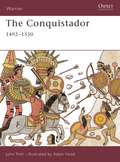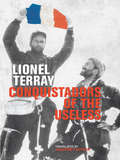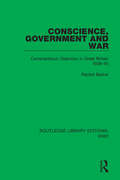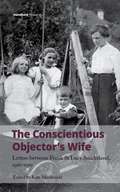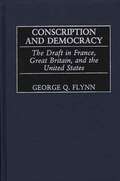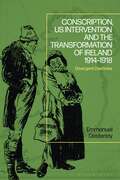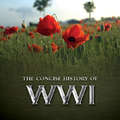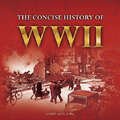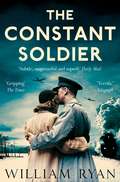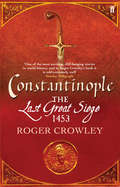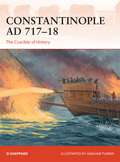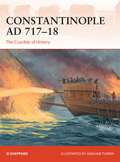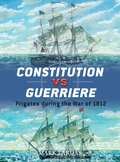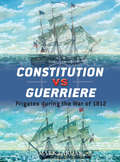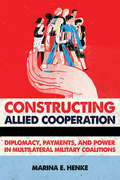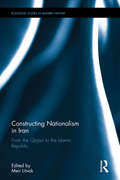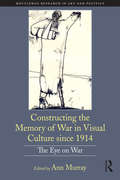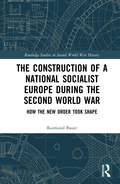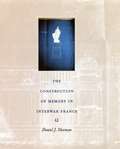- Table View
- List View
The Conquistador: 1492–1550 (Warrior #Vol.40)
by John Pohl Mr Adam HookMany accounts portray the conquest of the New World as a remarkable military achievement, with Cortés' vastly outnumbered but better armed Spaniards defeating hordes of superstitious savages. However, the reality of these events is far more complex and no less significant. The first Conquistadors who had sailed in search of prosperity, inspired by dreams of unlimited riches, soon became disillusioned and restless. With disease rampant, resources exhausted, and the Caribbean populations dwindling, they had little alternative but to find new territories and peoples to exploit. This title shows how, bolstered by influxes of war-hardened veterans from Europe and an army of over 30,000 allied Indian troops, they came to rely on and perfect what they knew best killing for profit, and without mercy.
Conquistadors of the Useless: From the Alps to Annapurna
by Lionel Terray'I have given my whole life to the mountains. Born at the foot of the Alps, I have been a ski champion, a professional guide, an amateur of the greatest climbs in the Alps and a member of eight expeditions to the Andes and the Himalayas. If the word has any meaning at all, I am a mountaineer.' So Terray begins Conquistadors of the Useless- not with arrogance, but with typical commitment. One of the most colourful characters of the mountaineering world, his writing is true to his uncompromising and jubilant love for the mountains. Terray was one of the greatest alpinists of his time, and his autobiography is one of the finest and most important mountaineering books ever written. Climbing with legends Gaston Rébuffat, Maurice Herzog and Louis Lachenal, Terray made first ascents in the Alps, Alaska, the Andes, and the Himalaya. He was at the centre of global mountaineering at a time when Europe was emerging from the shadow of World War II, and he came out a hero. Conquistadors tells of his war-time escapades, of life as an Alpine mountain guide, and of his climbs - including the second ascent of the Eiger North Face and his involvement in the first ever ascent of an 8,000-metre peak, Annapurna. His tales capture the energy of French post-war optimism, a time when France needed to re-assert herself and when climbing triumphs were more valued than at any other time in history. Terray's death, in the Vercors, robbed mountaineering of one of its most passionate and far-sighted figures. His energy, so obvious in Conquistadors of the Useless, will inspire for generations to come. A mountaineering classic.
Conscience, Government and War: Conscientious Objection in Great Britain 1939–45 (Routledge Library Editions: WW2 #6)
by Rachel BarkerThis book, first published in 1982, is a systematic and detached analysis of the 60,000 British conscientious objectors in the Second World War, forming an examination of the relationship between the individual and the State in time of war. It sets out to show how the British Government dealt with the challenge that conscientious objectors posed and how far it was able to correct the abuses and injustices that occurred in the First World War. It traces the background of pacifism between the Wars and the introduction of conscription, and gives a detailed account of the functioning of the Conscientious Objectors’ Tribunals and an assessment of their work. It goes on to examine the reactions and attitudes of Tribunal members, employers and the rest of the population, and how these were affected by the Government lead. It recounts the experience of objectors in civilian life and private and public employment, and how they fared in the armed forces and prisons. It also assesses the contributions made by the voluntary organisations who helped conscientious objectors in the war.
Conscience, Government and War: Conscientious Objection in Great Britain 1939–45 (Routledge Library Editions: WW2 #6)
by Rachel BarkerThis book, first published in 1982, is a systematic and detached analysis of the 60,000 British conscientious objectors in the Second World War, forming an examination of the relationship between the individual and the State in time of war. It sets out to show how the British Government dealt with the challenge that conscientious objectors posed and how far it was able to correct the abuses and injustices that occurred in the First World War. It traces the background of pacifism between the Wars and the introduction of conscription, and gives a detailed account of the functioning of the Conscientious Objectors’ Tribunals and an assessment of their work. It goes on to examine the reactions and attitudes of Tribunal members, employers and the rest of the population, and how these were affected by the Government lead. It recounts the experience of objectors in civilian life and private and public employment, and how they fared in the armed forces and prisons. It also assesses the contributions made by the voluntary organisations who helped conscientious objectors in the war.
The Conscientious Objector's Wife: Letters Between Frank and Lucy Sunderland, 1916-1919 (PDF)
by Kate MacdonaldFrank and Lucy Sunderland, English pacifists and fervent supporters of Labour politics and the Garden City movement, were separated in 1916 when Frank was given his prison sentence for being a conscientious objector. They wrote to each other from November 1916 until April 1919, while Frank was incarcerated at Wandsworth and Bedford prisons. Lucy looked after their three children in Letchworth, and earned enough to keep the family afloat by keeping hens, collecting insurance premiums and taking in sewing. This unique collection of letters is important as a working-class record of wartime experience. These letters show how their shared ideology of a socialist pacifism upheld the couple in separation, planning for a better future in a more equal society for all. The letters give contemporary evidence of events on the Letchworth Home Front: spotting airships, food rationing, hearing the London air-raids, the arrival of ‘Spanish flu’ in 1918, and the sufferings of the European civilian populations immediately after the war. For readers interested in the First World War, British politics, the Garden City movement, feminism and women’s emancipation, adult and workers’ education, Quakerism and pacifism
Conscription and Democracy: The Draft in France, Great Britain, and the United States (Contributions in Military Studies)
by George Q. FlynnFinding the manpower to defend democracy has been a recurring problem. Russell Weigley writes: The historic preoccupation of the Army's thought in peacetime has been the manpower question: how, in an unmilitary nation, to muster adequate numbers of capable soldiers quickly should war occur. When the nature of modern warfare made an all-volunteer army inadequate, the major Western democracies confronted the dilemma of involuntary military service in a free society. The core of this manuscript concerns methods by which France, Great Britain, and the United States solved the problem and why some solutions were more lasting and effective than others. Flynn challenges conventional wisdom that suggests that conscription was inefficient and that it promoted inequality of sacrifice.Sharing similar but not identical diplomatic outlooks, the three countries discussed here were allies in world wars and in the Cold War, and they also confronted the problem of using conscripts to defend colonial interests in an age of decolonization. These societies rest upon democratic principles, and operating a draft in a democracy raises several unique problems. A particular tension develops as a result of adopting forced military service in a polity based on concepts of individual rights and freedoms. Despite the protest and inconsistencies, the criticism and waste, Flynn reveals that conscription served the three Western democracies well in an historical context, proving effective in gathering fighting men and allowing a flexibility to cope and change as problems arose.
Conscription, US Intervention and the Transformation of Ireland 1914-1918: Divergent Destinies
by Emmanuel DestenayThis book analyses the relationship between the Irish home rule crisis, the Easter Rising of 1916 and the conscription crisis of 1918, providing a broad and comparative study of war and revolution in Ireland at the beginning of the Twentieth Century. Destenay skilfully looks at international and diplomatic perspectives, as well as social and cultural history, to demonstrate how American and British, foreign and domestic policies either thwarted or fed, directly or indirectly, the Irish Revolution. He readdresses-and at times redresses-the well established, but somewhat inaccurate, conclusion that Easter Week 1916 was the major factor in radicalizing nationalist Ireland. This book provides a more nuanced and gradualist account of a transfer of allegiance: how fears of conscription aroused the bitterness and mistrust of civilian populations from August 1914 onwards. By re-situating the Irish Revolution in a global history of empire and anti-colonialism, this book contributes new evidence and new concepts. Destenay convincingly argues that the fears of conscription have been neglected by Irish historiography and this book offers a fresh appraisal of this important period of history.
Conscription, US Intervention and the Transformation of Ireland 1914-1918: Divergent Destinies
by Emmanuel DestenayThis book analyses the relationship between the Irish home rule crisis, the Easter Rising of 1916 and the conscription crisis of 1918, providing a broad and comparative study of war and revolution in Ireland at the beginning of the Twentieth Century. Destenay skilfully looks at international and diplomatic perspectives, as well as social and cultural history, to demonstrate how American and British, foreign and domestic policies either thwarted or fed, directly or indirectly, the Irish Revolution. He readdresses-and at times redresses-the well established, but somewhat inaccurate, conclusion that Easter Week 1916 was the major factor in radicalizing nationalist Ireland. This book provides a more nuanced and gradualist account of a transfer of allegiance: how fears of conscription aroused the bitterness and mistrust of civilian populations from August 1914 onwards. By re-situating the Irish Revolution in a global history of empire and anti-colonialism, this book contributes new evidence and new concepts. Destenay convincingly argues that the fears of conscription have been neglected by Irish historiography and this book offers a fresh appraisal of this important period of history.
The Consise History of WWI
by Pat MorganOn 28 June 1914 in Sarajevo, a Bosnian Serb student shot the heir to the throne of the Austro-Hungarian Empire. The assassination plunged the world into a global conflict that was to scar human history and redefine the meaning of the word war .
The Consise History of WWII
by Liam McCannBy 1938 a second war in Europe seemed inevitable. It had only been twenty years since the war to end all wars, and the horrors of conflict were still fresh in the mind, but that didn't stop all sides re-arming and preparing for yet more bloodshed. The settlement at the end of World War One was neither clean nor decisive, and it punished Germany by confiscating territory and forcing the people to pay reparations to help rebuild France and reduce the Allied debt to America. This led to deep-seated anger and resentment among its people.
The Constant Soldier
by William Ryan'Haunting, passionate, William Ryan’s The Constant Soldier is a subtle WW2 thriller of horror and love with an utterly gripping countdown to Gotterdamerung.' - Simon Sebag Montefiore, author of Red Sky at Noon.Shortlisted for the HWA Endeavour Ink Gold Crown.1944. Paul Brandt, a soldier in the German army, returns wounded and ashamed from the bloody chaos of the Eastern front to find his village home much changed and existing in the dark shadow of an SS rest hut – a luxurious retreat for those who manage the concentration camps, run with the help of a small group of female prisoners who – against all odds – have so far survived the war. When, by chance, Brandt glimpses one of these prisoners, he realizes that he must find a way to access the hut. For inside is the woman to whom his fate has been tied since their arrest five years before, and now he must do all he can to protect her. But as the Russian offensive moves ever closer, the days of this rest hut and its SS inhabitants are numbered. And while hope – for Brandt and the female prisoners – grows tantalizingly close, the danger too is now greater than ever. And, in a forest to the east, a young female Soviet tank driver awaits her orders to advance . . .
Constantinople: The Last Great Siege, 1453
by Roger Crowley'Engagingly fresh and vivid . . . The 21-year-old Mehmet [the Ottoman Sultan] emerges from this book as ruthless but innovative, irascible but versatile and, above all, indefatigable - a worthy successor to Alexander and the Roman emperors he admired as much as any Muslim hero.' Malise Ruthven, Sunday TimesIn the spring of 1453, the Ottoman Turks advanced on Constantinople in pursuit of an ancient Islamic dream: capturing the thousand-year-old capital of Christian Byzantium. During the siege that followed, a small band of defenders, outnumbered ten to one, confronted the might of the Ottoman army in an epic contest fought on land, sea and underground.'In this account of the 1453 siege, written in crackling prose by former Istanbul resident Roger Crowley - his first book and not, I hope, his last - we are treated to narrative history at its most enthralling.' Christopher Silvester, Daily Express'A vivid and readable account of the siege . . . [And] an excellent traveller's guide to how and why Istanbul became a Muslim city.' Philip Mansel Guardian
Constantinople AD 717–18: The Crucible of History (PDF)
by Si SheppardThe siege of Constantinople in AD 717–18 was the supreme crisis of Western civilization. The Byzantine Empire had been reeling under the onslaught of Arabic imperialism since the death of the Prophet, whilst Jihadist armies had detached Syria, Palestine, Egypt, and Carthage from imperial control and were in the process of imposing their ascendancy at sea. The Empire had been reduced to its Anatolian and Balkan heartland, and Arab incursions threatened even this – Arab naval forces had appeared under the walls of Constantinople every year from AD 674 to 678. But all this was only a prelude to the massive combined-arms invasion force that advanced on the capital in 717. This title offers a comprehensive study of the ensuing clash between the ascendant Caliphate and the Empire at bay. It details the forces available to each side, with their respective advantages and vulnerabilities, evaluating the leadership qualities of the rival commanders and assessing their strategic and tactical initiatives. It also accounts for the trajectory and outcome of the campaign and emphasises the fundamental significance of the struggle. By holding the line, the Byzantines gave Europe enough time to develop at its own pace and emerge strong enough to face down its Islamic counterpart on equal terms. If Constantinople had fallen in 717, could Europe have endured as an independent entity? Could Christianity have survived as major religion? What would the future course of world history have been?
Constantinople AD 717–18: The Crucible of History (Campaign #347)
by Si SheppardThe siege of Constantinople in AD 717–18 was the supreme crisis of Western civilization. The Byzantine Empire had been reeling under the onslaught of Arabic imperialism since the death of the Prophet, whilst Jihadist armies had detached Syria, Palestine, Egypt, and Carthage from imperial control and were in the process of imposing their ascendancy at sea. The Empire had been reduced to its Anatolian and Balkan heartland, and Arab incursions threatened even this – Arab naval forces had appeared under the walls of Constantinople every year from AD 674 to 678. But all this was only a prelude to the massive combined-arms invasion force that advanced on the capital in 717. This title offers a comprehensive study of the ensuing clash between the ascendant Caliphate and the Empire at bay. It details the forces available to each side, with their respective advantages and vulnerabilities, evaluating the leadership qualities of the rival commanders and assessing their strategic and tactical initiatives. It also accounts for the trajectory and outcome of the campaign and emphasises the fundamental significance of the struggle. By holding the line, the Byzantines gave Europe enough time to develop at its own pace and emerge strong enough to face down its Islamic counterpart on equal terms. If Constantinople had fallen in 717, could Europe have endured as an independent entity? Could Christianity have survived as major religion? What would the future course of world history have been?
Constitution vs Guerriere: Frigates during the War of 1812 (Duel)
by Peter Bull Giuseppe Rava Mark LardasFamed as a classic naval duel, a one-on-one clash between two sailing frigates offered the victor immeasurable fame and glory. During the War of 1812, the Royal Navy and United States Navy squared off in four such duels, the most famous that between the USS Constitution and HMS Guerrière. Ships and tactics between the two nations varied enormously, with the American navy favouring a revolutionary design of frigate, with twenty-four pounder guns and heavy structural timbers, while the British, used to fighting the French and Spanish navies, relied on smaller, eighteen-pounder frigates. Through first-hand accounts of these four single-ship actions and fascinating comparisons of artillery, crew ability and tactical achievements, this book offers an unparalleled insight into the ruthless reality of frigate battles in the War of 1812.
Constitution vs Guerriere: Frigates during the War of 1812 (Duel #19)
by Peter Bull Giuseppe Rava Mark LardasFamed as a classic naval duel, a one-on-one clash between two sailing frigates offered the victor immeasurable fame and glory. During the War of 1812, the Royal Navy and United States Navy squared off in four such duels, the most famous that between the USS Constitution and HMS Guerrière. Ships and tactics between the two nations varied enormously, with the American navy favouring a revolutionary design of frigate, with twenty-four pounder guns and heavy structural timbers, while the British, used to fighting the French and Spanish navies, relied on smaller, eighteen-pounder frigates. Through first-hand accounts of these four single-ship actions and fascinating comparisons of artillery, crew ability and tactical achievements, this book offers an unparalleled insight into the ruthless reality of frigate battles in the War of 1812.
Constructing Allied Cooperation: Diplomacy, Payments, and Power in Multilateral Military Coalitions
by Marina E. HenkeHow do states overcome problems of collective action in the face of human atrocities, terrorism and the threat of weapons of mass destruction? How does international burden-sharing in this context look like: between the rich and the poor; the big and the small? These are the questions Marina E. Henke addresses in her new book Constructing Allied Cooperation. Through qualitative and quantitative analysis of 80 multilateral military coalitions, Henke demonstrates that coalitions do not emerge naturally. Rather, pivotal states deliberately build them. They develop operational plans and bargain suitable third parties into the coalition, purposefully using their bilateral and multilateral diplomatic connections—what Henke terms diplomatic embeddedness—as a resource. As Constructing Allied Cooperation shows, these ties constitute an invaluable state capability to engage others in collective action: they are tools to construct cooperation.Pulling apart the strategy behind multilateral military coalition-building, Henke looks at the ramifications and side effects as well. As she notes, via these ties, pivotal states have access to private information on the deployment preferences of potential coalition participants. Moreover, they facilitate issue-linkages and side-payments and allow states to overcome problems of credible commitments. Finally, pivotal states can use common institutional contacts (IO officials) as cooperation brokers, and they can convert common institutional venues into fora for negotiating coalitions.The theory and evidence presented by Henke force us to revisit the conventional wisdom on how cooperation in multilateral military operations comes about. The author generates new insights with respect to who is most likely to join a given multilateral intervention, what factors influence the strength and capacity of individual coalitions, and what diplomacy and diplomatic ties are good for. Moreover, as the Trump administration promotes an "America First" policy and withdraws from international agreements and the United Kingdom completes Brexit, Constructing Allied Cooperation is an important reminder that international security cannot be delinked from more mundane forms of cooperation; multilateral military coalitions thrive or fail depending on the breadth and depth of existing social and diplomatic networks.
Constructing Nationalism in Iran: From the Qajars to the Islamic Republic (Routledge Studies in Modern History)
by Meir LitvakNationalism has played an important role in the cultural and intellectual discourse of modernity that emerged in Iran from the late nineteenth century to the present, promoting new formulations of collective identity and advocating a new and more active role for the broad strata of the public in politics. The essays in this volume seek to shed light on the construction of nationalism in Iran in its many manifestations; cultural, social, political and ideological, by exploring on-going debates on this important and progressive topic.
Constructing Nationalism in Iran: From the Qajars to the Islamic Republic (Routledge Studies in Modern History)
by Meir LitvakNationalism has played an important role in the cultural and intellectual discourse of modernity that emerged in Iran from the late nineteenth century to the present, promoting new formulations of collective identity and advocating a new and more active role for the broad strata of the public in politics. The essays in this volume seek to shed light on the construction of nationalism in Iran in its many manifestations; cultural, social, political and ideological, by exploring on-going debates on this important and progressive topic.
Constructing the Memory of War in Visual Culture since 1914: The Eye on War (Routledge Research in Art and Politics)
by Ann MurrayThis collection provides a transnational, interdisciplinary perspective on artistic responses to war from 1914 to the present, analysing a broad selection of the rich, complex body of work which has emerged in response to conflicts since the Great War. Many of the creators examined here embody the human experience of war: first-hand witnesses who developed a unique visual language in direct response to their role as victim, soldier, refugee, resister, prisoner and embedded or official artist. Contributors address specific issues relating to propaganda, wartime femininity and masculinity, women as war artists, trauma, the role of art in soldiery, memory, art as resistance, identity and the memorialisation of war.
Constructing the Memory of War in Visual Culture since 1914: The Eye on War (Routledge Research in Art and Politics)
by Ann MurrayThis collection provides a transnational, interdisciplinary perspective on artistic responses to war from 1914 to the present, analysing a broad selection of the rich, complex body of work which has emerged in response to conflicts since the Great War. Many of the creators examined here embody the human experience of war: first-hand witnesses who developed a unique visual language in direct response to their role as victim, soldier, refugee, resister, prisoner and embedded or official artist. Contributors address specific issues relating to propaganda, wartime femininity and masculinity, women as war artists, trauma, the role of art in soldiery, memory, art as resistance, identity and the memorialisation of war.
The Construction of a National Socialist Europe during the Second World War: How the New Order Took Shape (Routledge Studies in Second World War History)
by Raimund BauerThroughout the Second World War, the term ‘Europe’ featured prominently in National Socialist rhetoric. This book reconstructs what Europe stood for in National Socialist Germany, analyses how the interplay of its defining elements changed dependent on the war, and shows that the new European order was neither an empty phrase born out of propaganda, nor was it anti-European. Tying in with long-standing traditions of German European, völkisch, and economic thinking, imaginations of a New Order became a central category in contemporary political and economic decision-making processes, justifying cooperation as well as exploitation, violence, and murder.
The Construction of a National Socialist Europe during the Second World War: How the New Order Took Shape (Routledge Studies in Second World War History)
by Raimund BauerThroughout the Second World War, the term ‘Europe’ featured prominently in National Socialist rhetoric. This book reconstructs what Europe stood for in National Socialist Germany, analyses how the interplay of its defining elements changed dependent on the war, and shows that the new European order was neither an empty phrase born out of propaganda, nor was it anti-European. Tying in with long-standing traditions of German European, völkisch, and economic thinking, imaginations of a New Order became a central category in contemporary political and economic decision-making processes, justifying cooperation as well as exploitation, violence, and murder.
The Construction of Memory in Interwar France
by Daniel J. ShermanOne of the bloodiest conflicts in human history, World War I devastated France, leaving behind battlefields littered with the remains of the dead. Daniel Sherman takes a close look at the human impact of this Great War by examining the ways in which the French remembered their veterans and war dead after the armistice. Arguing that memory is more than just a record of experience, Sherman's cultural history offers a radically new perspective on how commemoration of WWI helped to shape postwar French society and politics. Sherman shows how a wartime visual culture saturated with images of ordinary foot soldiers, together with contemporary novels, memoirs, and tourist literature, promoted a distinctive notion of combat experience. The contrast between battlefield and home front, soldier and civilian was the basis for memory and collective gratitude. Postwar commemoration, however, also grew directly out of the long and agonized search for the remains of hundreds of thousands of missing soldiers, and the sometimes contentious debates over where to bury them. For this reason, the local monument, with its inscribed list of names and its functional resemblance to tombstones, emerged as the focal point of commemorative practice. Sherman traces every step in the process of monument building as he analyzes commemoration's competing goals—to pay tribute to the dead, to console the bereaved, and to incorporate mourners' individual memories into a larger political discourse. Extensively illustrated, Sherman's study offers a visual record of a remarkable moment in the history of public art. It is at once a moving account of a culture haunted by war and a sophisticated analysis of the political stakes of memory in the twentieth century. Winner of the 2000 J. Russell Major Prize of the American Historical Association
Consume (The Clann #3)
by Melissa DarnellTristan Coleman has survived the change from Clann magic user to vampire, much to Savannah Colbert's joy—and despair. By changing the Clann's golden boy and newly elected leader, even to save him from death, she has unleashed a fury of hatred and fear that they cannot escape.
